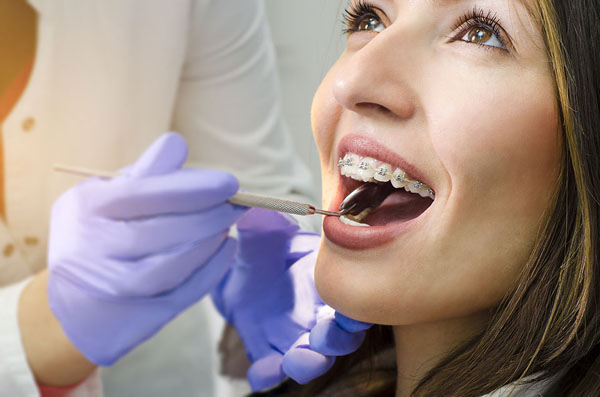The Role of Fluoride Treatments During Dental Cleanings
Protect Your Teeth With Fluoride
Visiting your dentist twice a year is essential to your oral health. During your biannual dental cleanings, dentists may apply fluoride to your teeth to protect and prevent future damage. Find out more about fluoride treatments by scheduling your next dental cleaning appointment with our Dearborn dentist by calling (313) 914-4440.
What Are Fluoride Treatments?
Fluoride treatments include applying fluoride to your teeth to strengthen the enamel, which is the hard outer layer of your teeth. Fluoride is a naturally occurring mineral that can be found in water, food, and soil. It’s added to toothpaste, mouthwash, and drinking water to help prevent tooth decay.
At your routine dental cleaning appointment, our dentist will offer a professional fluoride treatment. It usually takes just a few minutes to apply, and you can resume normal activities immediately afterward.
The Benefits of Fluoride Treatments
There are several benefits to fluoride Treatments, including:
- Prevents Tooth Decay: Fluoride can prevent tooth decay by strengthening the tooth enamel and making it more resistant to acid attacks from bacteria in the mouth.
- Reduces Sensitivity: It can reduce tooth sensitivity by strengthening the enamel and blocking exposed dentin tubules.
- Helps Remineralize Teeth: Fluoride treatments can also remineralize teeth that have been damaged by acid attacks, which can help reverse the early stages of tooth decay.
When Are Fluoride Treatments Necessary?
Dentists usually recommend fluoride treatments for individuals who are at a higher risk of developing tooth decay, including:
- Children and teenagers: They’re more prone to tooth decay because their teeth are still developing and aren’t as strong as adult teeth.
- Individuals with dry mouth: A dry mouth can increase the risk of tooth decay as saliva helps neutralize the acid in the mouth.
- Individuals with a history of cavities: Individuals who have had cavities in the past are more likely to develop them in the future.
- Individuals with braces or other orthodontic appliances: Braces and other orthodontic appliances can make it more difficult to clean teeth properly, increasing the risk of tooth decay.
Types of Fluoride Treatment
- Topical fluoride: This is applied directly to the teeth in the form of a gel, foam, or varnish. It’s often used in dental offices during routine cleanings or checkups.
- Fluoride mouthwash: A fluoride mouthwash is used to rinse the mouth after brushing and flossing. It’s widely available over the counter and can be used at home.
- Prescription fluoride toothpaste: This toothpaste contains a higher concentration of fluoride than regular toothpaste and is available only by prescription. It’s often recommended for people who are at high risk of tooth decay.
- Fluoride supplements: Fluoride supplements are available in tablet or liquid form and are taken orally. They’re often recommended for children who don’t have access to fluoridated water.
- Fluoride varnish: Fluoride varnish is a thick, sticky paste that’s painted onto the teeth. It dries quickly and is often used on children or people with sensitive teeth.
How the Fluoride Treatment Process Works
The fluoride treatment process is simple and painless. Before fluoride is applied, your dentist will perform a dental cleaning to remove any plaque or tartar buildup. From there, your dentist will apply a fluoride gel, foam, or varnish to your teeth using a brush, swab, or tray.
Your dentist will recommend keeping the fluoride in your mouth for a few minutes to allow it to absorb into your teeth. After a few minutes have passed, you can rinse your mouth to remove any excess fluoride.
Caring for Your Teeth After Fluoride Treatments
After your fluoride treatment, follow these tips to ensure the best results:
- Avoid eating or drinking anything for at least 30 minutes afterward.
- Don’t brush your teeth or rinse your mouth for at least four to six hours after the treatment.
- Avoid consuming foods or drinks that are high in sugar or acid.
- Brush your teeth twice a day with fluoride toothpaste.
- Floss daily to remove any food particles or plaque that may have accumulated in between your teeth.
Frequently Asked Questions
Is fluoride treatment safe for children?
Yes, fluoride treatment is safe for children. It’s often recommended for children and teenagers because their teeth are still developing and usually have a higher risk of cavities.
Can you have too much fluoride?
Yes, having too much fluoride can cause a condition called fluorosis. Fluorosis can cause white spots or brown stains on the teeth. However, fluoride treatment is safe when used in the recommended amounts and can improve your oral health.
Can fluoride treatment be done at home?
Fluoride treatment is usually done in a dental office. However, there are some over-the-counter products, such as fluoridated toothpaste, fluoride supplements, and mouthwash that can help strengthen tooth enamel.
How often should I get fluoride treatment?
Typically, professional fluoride treatments are done at your regular dental cleanings. However, the frequency of fluoride treatment depends on your individual needs and risk factors for tooth decay. Your dentist will recommend how often you should get fluoride treatment.
Prevent Cavities With Flouride Treatments
Fluoride treatment is a simple and effective way to strengthen tooth enamel and prevent tooth decay. It’s safe for children and adults and can benefit those at a higher risk of developing tooth decay. If you’re interested in fluoride treatment, talk to our Dearborn dentist about whether it’s the right treatment.


